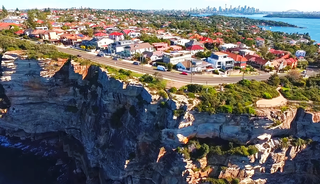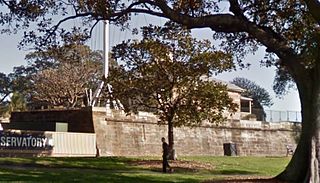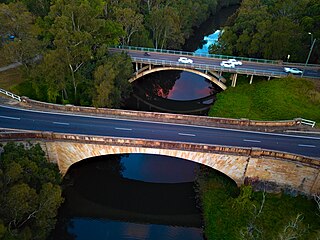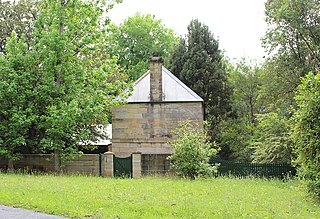
Admiralty House is the Sydney official residence of the Governor-General of Australia. It is located in the suburb of Kirribilli, on the northern foreshore of Sydney Harbour. This large Victorian Regency and Italianate sandstone manor, completed in stages based on designs by James Barnet and Walter Liberty Vernon, occupies the tip of Kirribilli Point. Once known as "Wotonga", it has commanding views across Sydney Harbour to the Sydney Harbour Bridge and the Sydney Opera House.

Braidwood is a town in the Southern Tablelands of New South Wales, Australia, in Queanbeyan–Palerang Regional Council. It is located on the Kings Highway linking Canberra with Batemans Bay. It is approximately 200 kilometres south west of Sydney, 60 kilometres inland from the coast, and fifty-five from Canberra. Braidwood is a service town for the surrounding district which is based on sheep and cattle grazing, and forestry operations.

Vaucluse is an eastern suburb of Sydney, in the state of New South Wales, Australia. It is located 8 kilometres (5 mi) north-east of the Sydney central business district, in the local government areas of Waverley Council and the Municipality of Woollahra.

Wyoming is a suburb of the Central Coast region of New South Wales, Australia, located 4 kilometres (2 mi) northeast of Gosford's central business district. It is part of the Central Coast Council local government area.
John Verge (1782—1861) was an English architect, builder, pioneer settler in the Colony of New South Wales, who migrated to Australia and pursued his career there. Verge was one of the earliest and the most important architect of the Greek Revival in Australia. He also brought more comprehensive range of Regency style than any contemporary architects. His design indicates the increasing of sophistication compared to previous architect's design.

Elizabeth Bay House is a heritage-listed Colonial Regency style house and now a museum and grotto, located at 7 Onslow Avenue in the inner eastern Sydney suburb of Elizabeth Bay in the City of Sydney local government area of New South Wales, Australia. The design of the house is attributed to John Verge and John Bibb and was built from 1835 to 1839 by James Hume. The grotto and retaining walls were designed by Verge and the carriage drive on Onslow Avenue was designed by Edward Deas Thomson and built from 1832 to 1835 by convict and free artisans under the direction of Verge. The property is owned by Sydney Living Museums, an agency of the Government of New South Wales. Known as "the finest house in the colony", Elizabeth Bay House was originally surrounded by a 22-hectare (54-acre) garden, and now situated within a densely populated inner city suburb.
Frederick Augustus Hely, a public servant and settler of colonial Australia, was born in County Tyrone, Ireland. He was the son of Colonel Forbes Francis Hely.

Fort Philip was a citadel style fort constructed as part of the first defensive works of the penal settlement of Sydney, located on Observatory Hill in the Sydney suburb of Millers Point, New South Wales, Australia. The fort has been demolished and the local government heritage-listed site repurposed as the Sydney Observatory.

The Gladesville Mental Hospital, formerly known as the Tarban Creek Lunatic Asylum, was a psychiatric hospital established in 1838 in the suburb of Gladesville, Sydney, New South Wales in Australia. The hospital officially closed in 1993, with the last in-patient services ceased in 1997.

Mortimer William Lewis was an English-born architect, surveyor and public servant who migrated to Australia and became Colonial Architect in the colony of New South Wales from 1835 to 1849. Lewis was responsible for designing and overseeing many government buildings in Sydney and rural New South Wales, many of which are heritage listed.

The Lansdowne Bridge is a heritage-listed road bridge that carries the Hume Highway across the Prospect Creek at Lansvale in the City of Fairfield local government area of New South Wales, Australia. It was designed and built from 1834 to 1836 by David Lennox. It is also known as Lennox Bridge. The property is owned by Roads and Maritime Services, an agency of the Government of New South Wales. It was added to the New South Wales State Heritage Register on 20 June 2000.

St Mark's Church is an active Anglican church in Darling Point, a suburb of Sydney, New South Wales, Australia. It is part of a significant local heritage group that includes the church, rectory, and adjacent cottage. The group forms part of a large collection of important to late 19th century buildings of considerable townscape, historic and cultural significance, including the former St Mark's Crescent School, St Mark's Cottage and Bishopscourt, formerly Greenoaks.

Carss Cottage is a heritage-listed former cottage and park ranger's residence and now historical museum at 74 Carwar Avenue, Carss Park, Georges River Council, New South Wales, Australia. It was built during 1865 by Scottish masons. The property is owned by the Georges River Council. It was added to the New South Wales State Heritage Register on 2 April 1999.

Engehurst is a heritage-listed residence located at 56a Ormond Street, Paddington in the Municipality of Woollahra local government area of New South Wales, Australia. It was designed by John Verge and built from 1834 to 1835. It was added to the New South Wales State Heritage Register on 2 April 1999.

Wyoming Cottage is a heritage-listed residence at 1 Wyoming Road, Cnr. Pacific Highway, Wyoming, Central Coast, New South Wales, Australia. It was designed by John Verge. It was added to the New South Wales State Heritage Register on 2 April 1999.

The Grange is a heritage-listed former stables and now residence at Renwick Street, Wyoming, Central Coast, New South Wales, Australia. It was designed by John Verge. It was added to the New South Wales State Heritage Register on 2 April 1999.

Timber Slab Cottage is a heritage-listed residence at 44 Barden Street, Tempe, Inner West Council, Sydney, New South Wales, Australia. It was built from 1840 to 1850. It is also known as Dover. It was added to the New South Wales State Heritage Register on 29 September 2000.

Goldfinders Inn is a heritage-listed former inn, guesthouse, general store and post office and now residence at 164 Old Bells Line of Road, Kurrajong, City of Hawkesbury, New South Wales, Australia. It was built from 1809 to 1830 by John Lamrock. It is also known as Gold Finders Rest, Kurrajong General Store and Kurrajong Post Office. It was added to the New South Wales State Heritage Register on 21 October 2016.

St John's Roman Catholic Church and Cemetery is a heritage-listed former school and now Roman Catholic church building located at Cordeaux Street, Campbelltown in the City of Campbelltown local government area of New South Wales, Australia. It was designed by John Joseph Therry and built from 1824 to 1841. It is also known as St. Johns Roman Catholic Church and Cemetery (former), Saint Johns Roman Catholic Church and St John the Evangelist Church. The property is owned by Trustees of the Roman Catholic Church. It was added to the New South Wales State Heritage Register on 2 April 1999.

Holly Lea and Plough Inn is a heritage-listed site at Holly Lea Road, Leumeah in the City of Campbelltown, New South Wales, Australia. The heritage listing includes a former residence, an inn and a storage shed. It was built from 1816 by William Ray. It is also known as Plough Inn; Three Brothers (inn); The Travellers' Home (inn); Borobine House; Hollylea; and William Ray's Cottage Inn Coolroom. The property is privately owned. It was added to the New South Wales State Heritage Register on 2 April 1999.




















